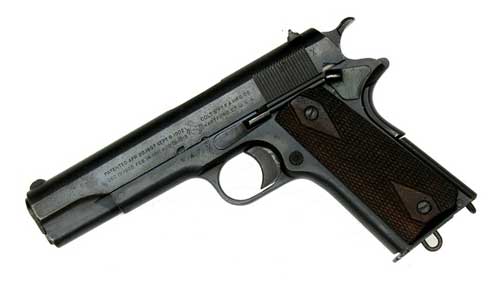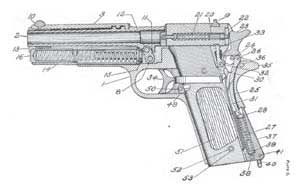1911 Design Features Used on Other Pistols

The 1911 is among the most recognizable pistol designs in the world, but the semiautomatic was not born overnight. In fact, the iconic firearm was a long, though worthwhile, effort to come up with a top-notch military sidearm.
Back in 1899 everyone sang Aud Lang Syne- and so the song goes. At the same time, the Mauser broomhandle pistol was gaining acceptance as a reliable and effective self-loading pistol. John Moses Browning developed the Colt 1900 .38 ACP pistol, and adventurers such as the up-and-coming T. E. Lawrence and western lawmen relied upon the single-action revolver. The United States Army was disappointed with the Colt .38 revolver and was actively looking to replace the Colt 1892 with a self-loading pistol. The Colt 1900 pistol was studied, and the German Luger was tested as well. John Browning and Colt were gaining much experience, as Browning designed small-caliber pistols and Colt manufactured them. The inertial firing pin, grip safety, enclosed slide, and tilting-link barrel were developed in these handguns. Browning also experimented with both internal and external extractors. Various hammerless designs were marketed, and while they were actually concealed-hammer pistols, the smooth slide design was popular.
Browning pioneered the locked-breech action as other makers struggled with adapting self-loading handguns to powerful cartridges. The Mauser 1896 used an oscillating wedge that worked well enough. This system was later used in the Walther P38 and today is in use with the Beretta 92 pistol. The Luger borrowed the Henry rifle's toggle lock, or perhaps Hugo Borchardt was impressed by Maxim's adaptation of the toggle for machine guns. Browning used the locked-breech operating principle. This design features a barrel and slide that remain locked as the pistol recoils. The barrel tilts at a certain point in its travel, and upon firing, the slide and the barrel recoil together. As the bullet exits the barrel and pressure abates, the slide and barrel separate, and the slide rushes forward to strip another round from the magazine and into the chamber. Practically every modern handgun now uses the Browning locked-breech design.
The Beginning
When the Army wanted a .45-caliber pistol, Browning took a hard look at his 1900 design, which was already refined into the 1903. The .45 ACP cartridge was designed to be the same length as the .38 ACP, with a .900-inch-long cartridge case, which simplified some of the development. He eliminated the 1900's dual links and used only one swinging link in the 1911, but the 1905 and 1907 Colt pistols still used not only dual links, but also the locking slot for the barrel used with the 1900. Just the same, the barrel bushing and trigger action later used in the 1911 were beginning to appear in the 1907 version of the Colt .45 automatic. In the style of the day, the Colt 1907 was offered with a shoulder stock slot (gangsters later modified the 1911 to shoulder stock status, along with extended magazines and even a full auto selector switch). The hammer style, lanyard loop, and ejection port received considerable attention. The somewhat square original grip angle was retained from the 1900 pistol.
The pistol was a good effort but Army testing found this Colt lacking. Safety was one concern, as the lack of a positive manual safety was a drawback for mounted use. The grip angle was rated uncomfortable. My research indicates that cavalry tests included carrying the Colt cocked and unlocked and ready to fire in the holster. Racking a slide was unacceptable for one-hand operation in a headlong battle from horseback and carrying the pistol loaded with the hammer down seemed unacceptable.
The pistol was further developed following a poor rating by the Army. Work on the Colt .45 automatic continued through the 1909 and 1910 models. The most noticeable change was the grip design. The dual links were finally eliminated. Seminal work on safety features included the addition of a grip safety, but the slide lock or thumb safety was last in development. The various mechanical improvements are important, but the improvements in the grip angle and handling are equally important. The proof of the 1911 Colt was an intensive firing test. The 1911 .45 was fired until too hot to handle, quenched in water for cooling, then fired until 6,000 rounds were exhausted without a malfunction. There were a couple of things the Army wanted they did not get, so a compromise was made. These wants included a loaded chamber indicator and a round counter. The brass round counter of the Savage 99 rifle may have made an impression upon the military but the practical application wasn't, well, practical. The 1911 magazine has witness holes for counting rounds. Modern 1911s have slots in the barrel for checking the loaded state but the press check is the most foolproof method of checking for a round in the chamber.

First Combat Action And The Rare "Black Army" Model
The 1911 acquitted itself well in the Philippines action. Rushed to the war zone immediately after adoption, hard-pressed soldiers put the 1911 to task. The 1911 went with Pershing to Mexico and then to Europe during World War One. It was during World War One that a now uncommon variation was introduced. Colt was used to producing a few thousand guns a year, but now the Army needed 300,000. As a result, Colt cut corners in some production demands, and one of the cut corners resulted in less polish and a darker finish. This became known as the "Black Army" finish. These handguns became rare after the war for two reasons: First, Colt's contract was canceled after the war ended. Second, most of the Black Army guns were refinished after World War One, and many were refinished in the new Parkerizing used during World War Two. The Army .45 did the business like no other, but as often happens at the end of a war, there was a list of complaints concerning the 1911. After World War one, Colt was asked to instigate a number of detail changes in the 1911 handgun. The 1911 was ushered off the stage, and the 1911A1 was developed.
This article is an excerpt of Gun Digest Shooter's Guide to the 1911, 2nd Edition by Robert K. Campbell.
 NEXT STEP: Download Your Free Storm Tactical Printable Target Pack
NEXT STEP: Download Your Free Storm Tactical Printable Target Pack
62 Printable MOA Targets with DOT Drills - Rifle Range in YARDS This impressive target pack from our friends at Storm Tactical contains 62 printable targets for rifle and handgun range use. Target grids and bullseye sizes are in MOA. Ideal for long-range shooting! Get Free Targets
1911 Design Features Used on Other Pistols
Source: https://gundigest.com/more/classic-guns/birth-1911-pistol
0 Response to "1911 Design Features Used on Other Pistols"
Post a Comment